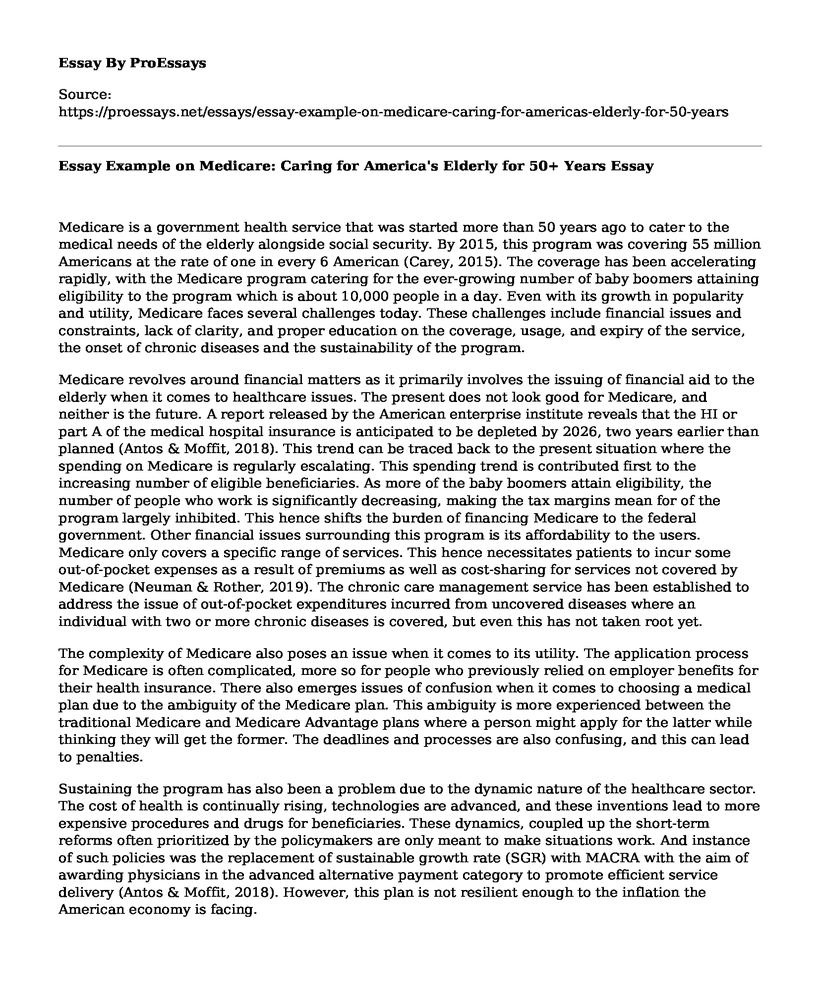Medicare is a government health service that was started more than 50 years ago to cater to the medical needs of the elderly alongside social security. By 2015, this program was covering 55 million Americans at the rate of one in every 6 American (Carey, 2015). The coverage has been accelerating rapidly, with the Medicare program catering for the ever-growing number of baby boomers attaining eligibility to the program which is about 10,000 people in a day. Even with its growth in popularity and utility, Medicare faces several challenges today. These challenges include financial issues and constraints, lack of clarity, and proper education on the coverage, usage, and expiry of the service, the onset of chronic diseases and the sustainability of the program.
Medicare revolves around financial matters as it primarily involves the issuing of financial aid to the elderly when it comes to healthcare issues. The present does not look good for Medicare, and neither is the future. A report released by the American enterprise institute reveals that the HI or part A of the medical hospital insurance is anticipated to be depleted by 2026, two years earlier than planned (Antos & Moffit, 2018). This trend can be traced back to the present situation where the spending on Medicare is regularly escalating. This spending trend is contributed first to the increasing number of eligible beneficiaries. As more of the baby boomers attain eligibility, the number of people who work is significantly decreasing, making the tax margins mean for of the program largely inhibited. This hence shifts the burden of financing Medicare to the federal government. Other financial issues surrounding this program is its affordability to the users. Medicare only covers a specific range of services. This hence necessitates patients to incur some out-of-pocket expenses as a result of premiums as well as cost-sharing for services not covered by Medicare (Neuman & Rother, 2019). The chronic care management service has been established to address the issue of out-of-pocket expenditures incurred from uncovered diseases where an individual with two or more chronic diseases is covered, but even this has not taken root yet.
The complexity of Medicare also poses an issue when it comes to its utility. The application process for Medicare is often complicated, more so for people who previously relied on employer benefits for their health insurance. There also emerges issues of confusion when it comes to choosing a medical plan due to the ambiguity of the Medicare plan. This ambiguity is more experienced between the traditional Medicare and Medicare Advantage plans where a person might apply for the latter while thinking they will get the former. The deadlines and processes are also confusing, and this can lead to penalties.
Sustaining the program has also been a problem due to the dynamic nature of the healthcare sector. The cost of health is continually rising, technologies are advanced, and these inventions lead to more expensive procedures and drugs for beneficiaries. These dynamics, coupled up the short-term reforms often prioritized by the policymakers are only meant to make situations work. And instance of such policies was the replacement of sustainable growth rate (SGR) with MACRA with the aim of awarding physicians in the advanced alternative payment category to promote efficient service delivery (Antos & Moffit, 2018). However, this plan is not resilient enough to the inflation the American economy is facing.
Conclusion
In conclusion, Medicare is a program that has indeed resulted in improved coverage and healthcare more so for the elderly. It has worked alongside social security and has significantly improved the health of many Americans. However, it has faced several challenges, among them the limitation on financing due to the high rate of aging for the baby boomers and low employable rates making the taxes limited to the federal government. The limited coverage of Medicare also forced people to incur out-of-pocket expenses, which inhibits healthcare affordability. The complexity of the plan is also troublesome. Lastly, the dynamics surrounding Medicare makes its sustainability troublesome.
References
Antos J. & Moffit R. E. (2018). The 2018 Medicare trustees report: fiscal and policy challenges. American enterprise institute. Retrieved from https://www.aei.org/wp-content/uploads/2018/07/The-2018-Medicare-Trustees-Report.pdf
Carey M. A. (2015). Medicare Turns 50 But Big Challenges Await. Kaiser health news. Retrieved from https://khn.org/news/medicare-turns-50-but-big-challenges-await/
Neuman T. & Rother J. (2019). Medicare at 50: lessons and challenges. American society on aging. Retrieved from https://www.asaging.org/blog/medicare-50-lessons-and-challenges
Cite this page
Essay Example on Medicare: Caring for America's Elderly for 50+ Years. (2023, Jan 16). Retrieved from https://proessays.net/essays/essay-example-on-medicare-caring-for-americas-elderly-for-50-years
If you are the original author of this essay and no longer wish to have it published on the ProEssays website, please click below to request its removal:
- Population, Health Behavior, and Underlying Reasons for the Behavior
- Collisions in Washington State Paper Example
- Supplements for Strength-Power Athletes Paper Example
- The Rohingya Community Essay Example
- Nursing Styles of Leadership Paper Example
- Essay Sample on Change from Pediatrics to Psychiatry: Reasons for a Career Shift
- Remote Collaborations: Navigating Challenges During Covid-19 Outbreak - Essay Sample







